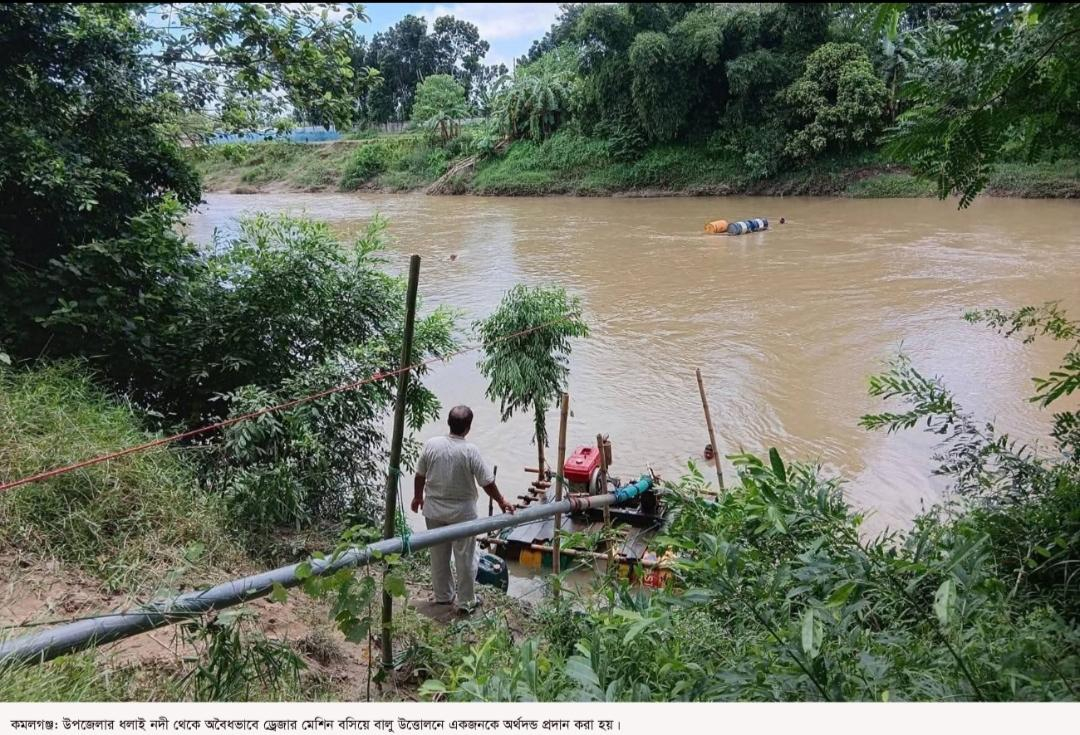Published: 06:51 AM, 28 August 2025
Illegal Sand Lifting Continues Unabated: A Disaster for Streams, Rivers, Environment, and Human Life in Moulvibazar

Sangram Datta: Illegal sand lifting continues unabated in the rivers and streams of Kulaura, Juri, Kamalganj, and Srimangal upazilas of Moulvibazar district—posing grave threats to the environment, biodiversity, agriculture, and human life.
Powerful gangs, allegedly backed by influential figures, are involved in extracting and smuggling sand from different sites across the district. Despite occasional drives where trucks are seized, drivers fined, or helpers detained, the masterminds behind the trade—the “godfathers”—largely remain untouchable due to their strong political connections.
Even international media have taken notice. On August 16, 2025, BBC News Bangla published a report titled “Moulvibazar’s silica sand is being looted indiscriminately.”
Open Sand Looting at Gagcherra in Srimangal:
On the way to the Nazarin Mission at Noagaon village under Srimangal Union, sand has long been extracted from the Gagcherra stream near a biscuit factory. Local sources alleged that an organized syndicate led by Shiplu, Masum, and Shahed oversees the operation.
The sand is transported on trucks through the lands of noted industrialist Sirajul Islam Harun Mia and former Srimangal Union Parishad chairman Rasendra Datta Chowdhury.
Residents—particularly from the minority community—fear naming the syndicate leaders, though they describe the situation as an “open secret.” Industrialist Sirajul Islam Harun reportedly intervenes occasionally, sending his men to halt the operation, but it quickly resumes in secrecy.
Floods in Villages from Phulchhara:
At Phulchhara near Uttarsur Talatala village, adjacent to Dwarika Pal College in Srimangal, illegal sand extraction has already caused flooding in surrounding villages during the rainy season.
Frustrated locals recently submitted a memorandum to the Upazila Executive Officer demanding an immediate halt to these unlawful activities.
Administrative Action and UNO’s Firm Stand:
On August 26, a mobile court was conducted in Srimangal under the directive of Moulvibazar Deputy Commissioner Md. Israil Hossain.
The drive, led by Assistant Commissioner (Land) and Executive Magistrate Md. Mohibullah Akon, with assistance from a Bangladesh Army team, seized nearly 500 cubic feet of illegally extracted sand.
Upazila Nirbahi Officer (UNO) Md. Islam Uddin emphasized the administration’s commitment:
“The Upazila administration is firmly committed to stopping illegal sand mining. Mobile courts will continue to operate regularly to protect the local environment and communities.”
He added that red flags and bamboo barricades have been placed at vulnerable sand mining spots to restrict truck movement. He urged citizens to comply with the Sand and Soil Management Act, 2010 to protect rivers, biodiversity, and agricultural land.
The following day, August 27, in the presence of Army personnel, the Assistant Commissioner inspected the Gopalacherra sand site in Ashidron Union. The lessee was strictly warned to confine extraction within the officially leased boundary and avoid prohibited areas around Motiganj Bridge.
Journalists Raising Their Voices:
Local journalists have also been vocal against sand looting.
Anwar Hossain Jasim, Srimangal correspondent of Daily Inquilab, posted on his verified Facebook page: “Sand is being extracted with dredgers from Motiganj’s Bilash Chhara; action should be taken against them.”
Nurul Mohaimin Milton, Kamalganj correspondent of The Daily Ittefaq, warned in his social media post that uncontrolled sand extraction in Dhulai and Lagata Rivers is eroding riverbanks and displacing families.
Md. Saiful Islam, Moulvibazar correspondent of Daily Kaler Kantho, urged action against certain “influential journalists” allegedly aiding the sand syndicate, though no names were revealed.
Accidents and Fatalities:
The menace is not limited to environmental destruction. Illegal sand-laden trucks frequently cause road accidents. In Bhunbeer and Sindurkhan unions of Srimangal, three people were killed in two separate incidents involving such trucks, leaving communities in shock and fear.
The Situation in Other Upazilas:
Kamalganj: Sand mining from Dhulai and Laghata rivers is causing erosion, sweeping away homes.
Kulaura: A contractor’s manager was fined for exceeding lease limits.
Juri: Locals formed human chains to protest reckless dredger operations that are destroying farmland and eroding riverbanks—yet illegal lifting continues.
Government Leases vs. Illegal Trade:
Officially, Moulvibazar has 52 silica sand quarries, of which 33 are under legal lease. However, many river streams continue to be mined illegally—often even after lease periods expire. Such practices, in defiance of court orders, are devastating the environment.
Environmentalists’ Warning:
The Bangladesh Environmental Lawyers Association (BELA) has strongly criticized administrative lapses in preventing illegal sand lifting. Advocate Shah Saheda Akter remarked:
“It is the administration’s duty to prevent illegal sand extraction. Those who allow it are violating court orders.”
Environmentalists further warn that if these practices persist, Moulvibazar’s sand and stone resources could face the same fate as Bholaganj—once rich in natural resources, now nearly exhausted.
Conclusion:
The rivers and streams of Moulvibazar are not merely natural features; they are lifelines sustaining agriculture, biodiversity, and communities. Yet, unchecked illegal sand mining threatens to destroy them.
While raids and drives take place, the masterminds remain untouched. Unless decisive action is taken now, Moulvibazar’s rivers, streams, and natural beauty may disappear—buried under the greed of sand syndicates, leaving future generations with nothing but regret.




